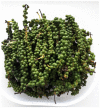Effects of Piper nigrum L. Fruit Essential Oil Toxicity against Stable Fly (Diptera: Muscidae)
- PMID: 36903904
- PMCID: PMC10005248
- DOI: 10.3390/plants12051043
Effects of Piper nigrum L. Fruit Essential Oil Toxicity against Stable Fly (Diptera: Muscidae)
Abstract
The efficacy of Piper nigrum L. fruit essential oil (EO) against Stomoxys calcitrans (stable fly), a blood-feeding fly distributed worldwide, was investigated. This study aimed to evaluate the insecticidal activity of EO based on contact and fumigant toxicity tests. Chemical analysis of the EO using gas chromatography-mass spectrometry revealed that sabinene (24.41%), limonene (23.80%), β-caryophyllene (18.52%), and α-pinene (10.59%) were the major components. The results demonstrated that fly mortality increased with increasing EO concentration and time during the first 24 h of exposure. The median lethal dose was 78.37 µg/fly for contact toxicity, while the 90% lethal dose was 556.28 µg/fly. The median lethal concentration during fumigant toxicity testing was 13.72 mg/L air, and the 90% lethal concentration was 45.63 mg/L air. Our findings suggested that essential oil extracted from P. nigrum fruit could be a potential natural insecticidal agent for control of stable fly. To examine the insecticidal properties of P. nigrum fruit EO, further field trials and investigation into the efficacy of nano-formulations are required.
Keywords: Piper nigrum; contact toxicity; fly vector; fumigant toxicity; insecticide; stable flies.
Conflict of interest statement
The authors declare no conflicts of interest.
Figures
Similar articles
-
Contact and Fumigant Activities of Citrus aurantium Essential Oil against the Stable Fly Stomoxys calcitrans (Diptera: Muscidae).Plants (Basel). 2022 Apr 21;11(9):1122. doi: 10.3390/plants11091122. Plants (Basel). 2022. PMID: 35567123 Free PMC article.
-
Insecticidal Activity of Plectranthus amboinicus Essential Oil against the Stable Fly Stomoxys calcitrans (Diptera: Muscidae) and the Horse Fly Tabanus megalops (Diptera: Tabanidae).Insects. 2022 Mar 3;13(3):255. doi: 10.3390/insects13030255. Insects. 2022. PMID: 35323553 Free PMC article.
-
Contact and fumigant toxicity of a botanical-based feeding deterrent of the stable fly, Stomoxys calcitrans (Diptera: Muscidae).J Agric Food Chem. 2011 Sep 28;59(18):10394-400. doi: 10.1021/jf2016122. Epub 2011 Aug 26. J Agric Food Chem. 2011. PMID: 21848320
-
Bio-activities of Clerodendrum inerme extracts, essential oil, main terpenes and Ag nanoparticles against the stable fly, Stomoxys calcitrans (Diptera: Muscidae) and their non-target effects against its parasitoid, Spalangia cameroni (Hymenoptera: Pteromalidae) and earthworms.Vet Parasitol. 2025 Jul;337:110497. doi: 10.1016/j.vetpar.2025.110497. Epub 2025 May 13. Vet Parasitol. 2025. PMID: 40381232
-
Chemical Constituents of the Essential Oil Extracted from Elsholtzia densa and Their Insecticidal Activity against Tribolium castaneum and Lasioderma serricorne.Foods. 2021 Sep 28;10(10):2304. doi: 10.3390/foods10102304. Foods. 2021. PMID: 34681355 Free PMC article.
Cited by
-
Plant Essential Oils as Biopesticides: Applications, Mechanisms, Innovations, and Constraints.Plants (Basel). 2023 Aug 10;12(16):2916. doi: 10.3390/plants12162916. Plants (Basel). 2023. PMID: 37631128 Free PMC article. Review.
-
A Review of Botanical Extracts with Repellent and Insecticidal Activity and Their Suitability for Managing Mosquito-Borne Disease Risk in Mexico.Pathogens. 2024 Aug 29;13(9):737. doi: 10.3390/pathogens13090737. Pathogens. 2024. PMID: 39338928 Free PMC article. Review.
-
Synergistic Potential of Trikatu Essential Oil as an Aromatherapy Agent: A Chemical and Mechanistic Review.Drug Des Devel Ther. 2025 Aug 5;19:6751-6776. doi: 10.2147/DDDT.S534731. eCollection 2025. Drug Des Devel Ther. 2025. PMID: 40786247 Free PMC article. Review.
References
Grants and funding
LinkOut - more resources
Full Text Sources



